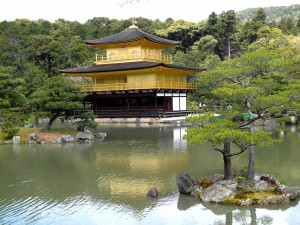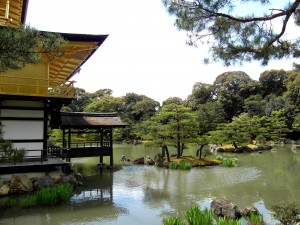2014-09-01: Continuing on from where I left off on this topic …
Creative Architecture In Context is not a revolutionary concept … not even a new concept … it is an ancient concept … practiced long, long before the pompous Architect of the 19th Century was born … and even before he was a gleam of excitement in his father’s eye !
The Kinkaku-ji Temple … also known as The Golden Pavilion … is a Buddhist Temple in the north-west of central Kyoto City, Japan. Very briefly … this building was commissioned in 1394 by Ashikaga Yoshimitsu (1358-1408), Japan’s 3rd Shogun, and completed in 1397. In accordance with his final wishes, it was transformed into a Zen Temple of the Rinzai School in 1419.
The Temple is a simple, elegant building … but, it exists in a specific setting … a landscape of Zen-style gardens, and a large pond which reflects the building. The pond (Kyoko-chi) was there before the Temple was built.

The landscaping around the building is a fine example of Muromachi-period (14th-16th Centuries) garden design … considered a classical age in Japan … where the relationship between a building and its setting was greatly emphasized … in a precise artistic way, fully integrating the structure within the landscape … resulting in a dynamic, harmonious balance between building and nature.

In this example … the word ‘Architecture’, on its own, is entirely inadequate to describe the symbiotic relationship between this building and its setting/context. Prefixes, such as ‘eco-‘ or ‘bio-‘ or ‘whatever-‘ before ‘Architecture’ … are also far too weak to communicate either the meaning or the importance of this relationship.
A Radically New Term is Necessary …
ECOLOGY+ARCHITECTURE
Its setting … nature, landscape, plants and animals, etc … must be considered at the earliest stages of a building’s design … with the aim of achieving, in the completed construction, a dynamic and harmonious balance between the two.
This is not how Architecture is taught today in the schools … or practiced by professionals, who are constrained by conventional and overly restrictive boundaries … and cannot or do not, therefore, look beyond their own buildings.
This must change !
And of course … the concept of Creative Architecture In Context must be re-interpreted and implemented in a manner which is suitably adapted to the 21st Century … but that is a story for another day !!
.
.
END
